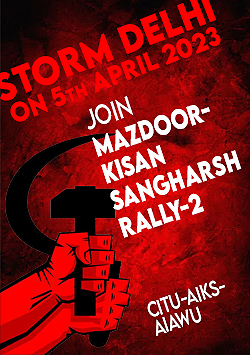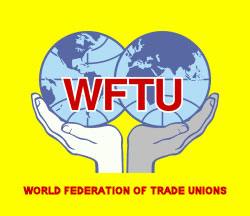Tapan Sen
Global capitalist order is passing through the deepest crisis ever with unprecedented recession-stagnation-inflation, rise of right-populist-authoritarianism and endless attacks on the toiling masses; followed by heroic events of gallant Resistances and Revolts.
Rightwing Economic, Communal & Authoritarian Attacks
It is promoting the pervert private accumulations through non-productive routes arising from state-sponsored monopolistic exercise, interests, rents, speculative gains and other forms of extractions. The state-sponsored encroachment-coercion-generated surplus has colossally surpassed the “production linked profit”; expropriation has taken over appropriation. Prolonging recessionary situation with unprecedented accumulation in fewer hands, along with widening/deepening of mass impoverishment, widening the gap between production and purchasing power of people and, hence, under-consumption. These are all the expressions of inevitable structural vulnerability of the capitalist system.
The global systemic crisis has grievously impacted the Indian economy, politics and society with the rise of the most authoritarian right-wing divisive regime after independence. The regime is also thoroughly anti-people and avowedly pro-corporate and pro-big business, being displayed by all its legislative, administrative and societal policy drives which are also damaging the national economy. The path of horizontal expansion of the economy, so long followed despite all systemic limitations, has been totally subverted to promote vertical centralisation of control of the economy with deeper monopolisation in favour of large corporate class, both foreign and domestic. Along with that, consistent machinations are going on the democratic system towards rabid authoritarian onslaught on constitutional provisions, democratic rights and right to expression and dissent through numerous administrative measures like UAPA, framing of sedition cases and various other manners.
And, the most crucial has been the aggressive onslaught of communal divisive machinations on the society aimed at communal polarization by the RSS/BJP bandwagons with the active patronization of administration. The aim is to desperately push through their project of majoritarian Hindutva regime to create a sense of terror among the minorities and also to create an overarching Hindutva identity among the people cutting across the social-ethnic divide; finally to divert the attention of the people from the increasing disaster on their lives and livelihood and at the same time facilitate the consolidation of the right wing authoritarian regime.
These, in fine, reveal the comprehensive project of the ruling class to sustain their loot in the midst of aggravating systemic crisis through complete authoritarianisation of the entire system of governance being pushed through by the corporate-communal nexus in governance at the Centre.
With this aggravation of the crisis, more desperate move is being made by the ruling class to further restructure and overhaul the economy management in more retrograde as well as authoritarian direction which is intensifying the destructive onslaught both on the lives of the people and also on the national economy.
It continues to shower tax concessions/incentives/rebates through various routes to the rich and tried to balance the loss in revenue through a phenomenal rise in indirect taxes on the working people. The Modi government had done away with the wealth tax in 2016 which was followed by reduction in corporate tax rate from 30% to 22% in 2019. Subsequently, concessional corporate tax at 15% has been introduced for the new entrepreneurs, which is also being availed by big corporate through proxy. Over and above, the tax administration has been so tuned and tutored that every year around Rs 5 to 7 lakh crore remain uncollected/unpaid by the corporate on account of income and corporate taxes.
Simultaneously, burden of indirect tax has been phenomenally increased through GST regime and even on the food items, milk and essential medicines. Indirect tax on petro products saw the steepest increase. Excise duty on petrol was Rs 9.48 per litre and Rs 3.56 on diesel in 2014 and rose to a record Rs 32.98 and Rs 31.83, respectively, in May 2020. The extraction on common people on account of fuel related tax and pricing has increased through this draconian expropriation mechanism by 186% during 2014-15 and 2021-22 from Rs 1.72 lakh crore to Rs 4.92 lakh crore. In FY 2021, India’s direct tax collection was 9.45 lakh crores (4.7% of GDP) while the indirect tax collection was at 10.71 lakh crores (5.4% of GDP and more than 53% of the total tax collection) where as the OECD countries’ average for indirect tax is around 33% of the total tax collection.
The government of the day shamelessly speeded up the process of organized pilferage of Banking system’s resources by way of legitimizing deliberate debt-default to big corporate through Insolvency Bankruptcy Procedure being operated by National Company Law Tribunal. Now the debt defaulter companies reporting bankruptcy will be dealt by National Company Law Tribunal and whole procedure will end up with another private corporate taking over in lieu of small fraction of the total debt liability of the bankrupt company. Rest of the debt amount will be foregone by the Bank; such illegitimate sacrifice forced upon the concerned Bank is termed as Haircut.
Phasing out the subsidy and allocation on welfare/social accounts has been another driving feature of neoliberalism; during Modi-regime it attained a disastrous height. The food subsidy has been slashed by more than 27%, by around Rs 80,000 crore in the 2022-23 Budget in the face of increase in intensity of hunger. Similarly, the fertiliser subsidy has been cut to Rs 1,05,222 crore in 2022-23, a nearly 25% drop.
Inflation has already crossed the RBI prescribed limit. This in the background of continuously depressing income situation for the people at large, leads to lesser consumption and thereby drastic cut in capacity utilization in industries and services, thereby degenerating the employment and income situation further, fall in investment and resultant destruction of employment and productive forces. This vicious cycle of inflation-stagnation with recession demonstrates the nauseating perversion in the economy.
The conspired attack on labour by the ruling class to put the whole burden of crisis is simultaneously three-folded, one is to informalise the formal sector; second, to increasing application of automation and Artificial intelligence in the manufacturing and another is to enhance GIG and service sector dependence in economy. The result is decline of employment together with faster pace of informlisation of employment relations in various formats.
(a) Greater informalisation, fragility and heterogeneity in the same workplace are taking place across the sectors accompanied by downsizing of workforce; (b) direct loot on the people setting in faster motion of expropriation process with imposition of huge indirect tax-burden and other forms of rents over infrastructural assets and natural resources, unmistakably accompanied by sharp reduction of direct taxes on corporate/big businesses together with various rebates and exemptions; and (c) opening up of new avenues of profiteering both in industries, services, infrastructure and public utilities for the private corporates practically without or least investment on their part, with Govt. support and huge subsidy from public exchequer to pave the path of further assured wealth accumulation for them.
Casualisation and contractualisation of workforce in various formats were being incessantly pursued in the manufacturing as well as infrastructure and services for long. With the advent of automation and modernization of technologies, the decline of permanent workers in manufacturing sector had been speeded up, while the contract workers had been pushed towards the level of pauperisation burdened with an unimaginable physical and mental distress.
The share of contract workers in total workforce in the public sector manufacturing and engineering industries has already crossed more than 50 to 60 per cent and in certain sectors like petroleum, BHEL, powergrid, NTPC, NHPC etc has reached over 70 to 75% on the average or more. In addition to that, a newer and evidently hitherto the most fragile labour force is emerging in the form of apprentices/ trainees through various govt sponsored schemes like ‘On Job Trainees (OJTs)’, ‘Long Term Trainee Employees (LTTEs)’, ‘Learn while you Earn’, ‘Junior Executives’, ‘Fixed Term Employees (FTEs)’ or ‘NEEM’, ‘NETAP’ and ‘SITA’ scheme trainees etc. Permanent workers are conspicuously reduced to insignificant presence; even below 10% of the total workforce in some industries.
The newest plot of ruling-class is to further lower the labour-cost by recruiting more and more number of apprentices/trainees in core production processes in practically no-wages while making their existence completely vulnerable by amending the labour laws (IR Code) by excluding apprentices/trainees from the definition of workmen. And to this end, the Modi Govt got the Apprenticeship Act 1961 and the related Rules of 1992 amended in 2015 and 2019 respectively.
For enhancing the productivity of every unit of labour, intensity of work and increase in workload per labour time, sometimes in terms of minutes or fraction thereof are taking place. Automation and resultant obvious de-skilling are continuously outmoding the necessity of dedicated-task-specific experienced labour-power. The mode of production is moving towards a direction where the fresh trainee-batches with a huge reserve army of unemployed vocationally educated youths, with the most state-of-the-art knowledge of automation and technology and skill to learn fast are going to be burdened with the whole core responsibility of the production process.
Entire exercise of restructuring is aimed at, further depressing the employment situation, and totally informalise the already fragile employment relations in the organized sector as well so that the very basic concept statutory fixed working hours, minimum wages and social security along with the right to organize and collective action are completely eliminated circumstantially from the workplaces and condition of virtual slavery is imposed. Enactment of Labour Codes has already set the motion in that direction.
Resistance and struggles
Working class struggle must comprehend this entire process of restructuring of employment relations as well as economy/asset management to effectively combat the same through the heightened struggle both for resistance as well as for change towards pro-people alternative.
Towards this end, while heightening the level of united struggles of the toiling class premised on the comprehensive understanding of the new attacks of so called restructuring towards promoting perverted crony capitalist order, the working class also must unfailingly intensify its consistent organized conscious interventions to combat the disastrous machinations of hindutva ideology on the society by the corporate-communal regime. It is a political and ideological fight as well, which must intensify along with the organized class-combat.
The 17th Conference of CITU has been tasked with to strategies the organised united combat against the anti-people and anti-national regime with full comprehension of the comprehensive strategy of corporate-communal nexus in governance in all its facets.


